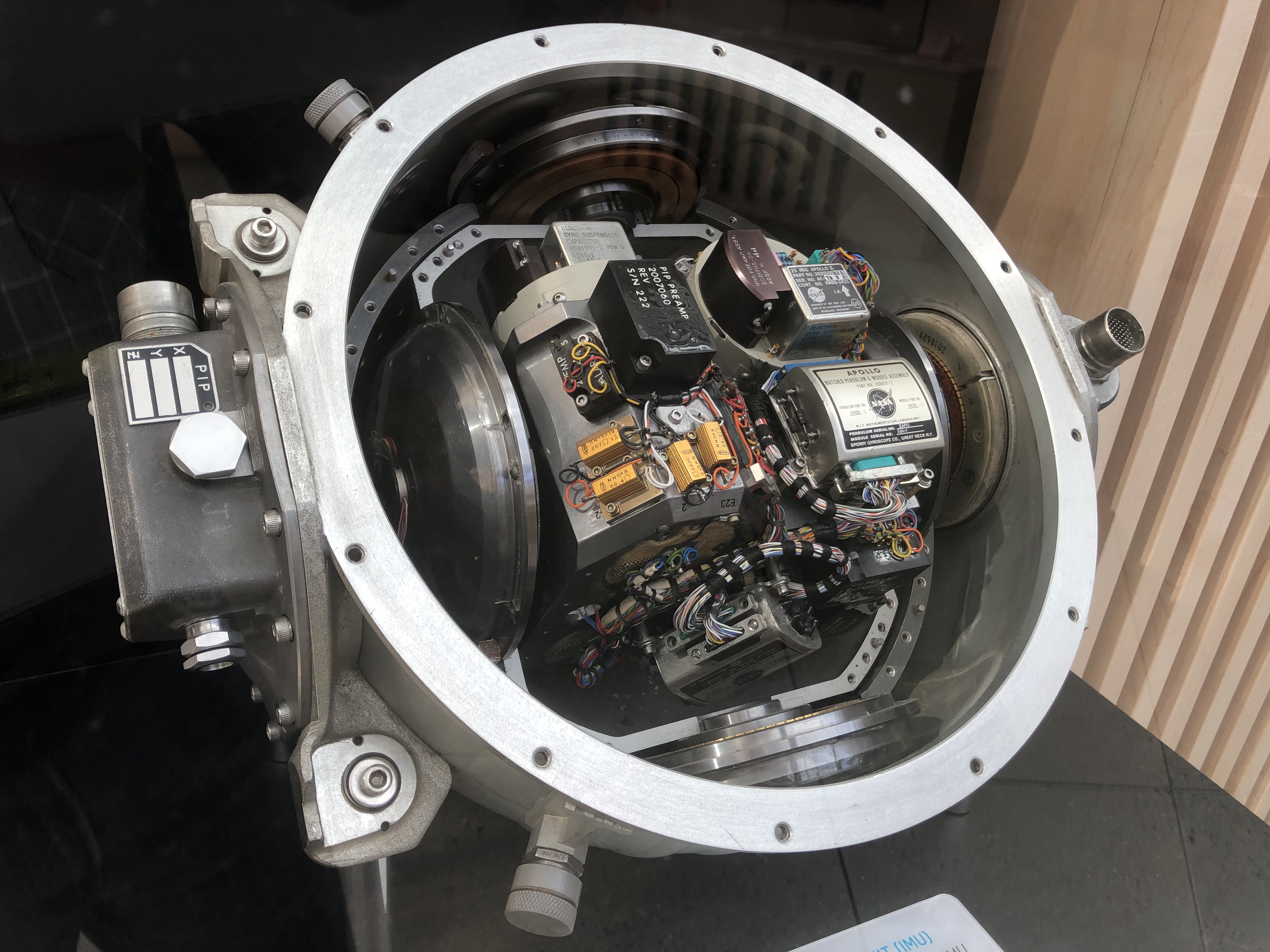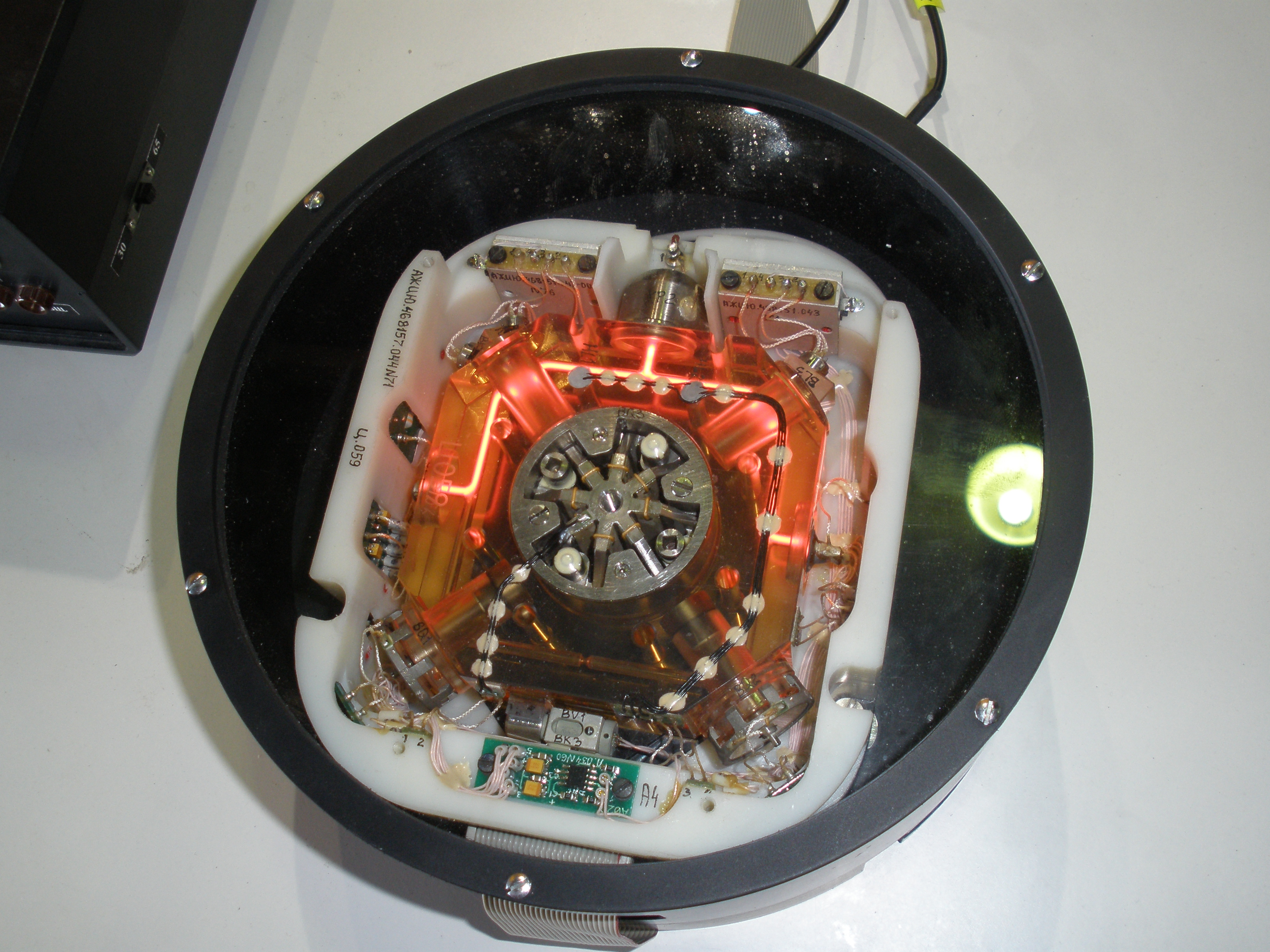|
Fibre-optic Gyroscope
A fibre-optic gyroscope (FOG) senses changes in orientation using the Sagnac effect, thus performing the function of a mechanical gyroscope. However its principle of operation is instead based on the interference of light which has passed through a coil of optical fibre, which can be as long as . Operation Two beams from a laser are injected into the same fibre but in opposite directions. Due to the Sagnac effect, the beam travelling against the rotation experiences a slightly shorter path delay than the other beam. The resulting differential phase shift is measured through interferometry, thus translating one component of the angular velocity into a shift of the interference pattern which is measured photometrically. Beam splitting optics split light from a laser diode (or other laser light source) into two waves propagating in both clockwise and anticlockwise directions through a coil consisting of many turns of optical fibre. The strength of the Sagnac effect is depende ... [...More Info...] [...Related Items...] OR: [Wikipedia] [Google] [Baidu] |
Control Theory
Control theory is a field of mathematics that deals with the control system, control of dynamical systems in engineered processes and machines. The objective is to develop a model or algorithm governing the application of system inputs to drive the system to a desired state, while minimizing any ''delay'', ''overshoot'', or ''steady-state error'' and ensuring a level of control Stability theory, stability; often with the aim to achieve a degree of Optimal control, optimality. To do this, a controller with the requisite corrective behavior is required. This controller monitors the controlled process variable (PV), and compares it with the reference or Setpoint (control system), set point (SP). The difference between actual and desired value of the process variable, called the ''error'' signal, or SP-PV error, is applied as feedback to generate a control action to bring the controlled process variable to the same value as the set point. Other aspects which are also studied are con ... [...More Info...] [...Related Items...] OR: [Wikipedia] [Google] [Baidu] |
Quantum Gyroscope
A quantum gyroscope is a very sensitive device to measure angular rotation based on quantum mechanical principles. The first of these was built by Richard Packard and his colleagues at the University of California, Berkeley. The extreme sensitivity means that theoretically, a larger version could detect effects like minute changes in the rotational rate of the Earth. Principle In 1962, Cambridge University PhD student Brian Josephson hypothesized that an electric current could travel between two superconducting materials even when they were separated by a thin insulating layer. The term ''Josephson effect'' has come to refer generically to the different behaviors that occur in any two weakly connected macroscopic quantum systems—systems composed of molecules that all possess identical wavelike properties. Among other things, the Josephson effect means that when two superfluids (zero friction fluids) are connected using a weak link and pressure is applied to the superfluid ... [...More Info...] [...Related Items...] OR: [Wikipedia] [Google] [Baidu] |
Vibrating Structure Gyroscope
A vibrating structure gyroscope, defined by the IEEE as a Coriolis vibratory gyroscope (CVG), is a gyroscope that uses a vibrating structure to determine the rate of rotation. A vibrating structure gyroscope functions much like the halteres of flies (insects in the order Diptera). The underlying physical principle is that a vibrating object tends to continue vibrating in the same plane even if its support rotates. The Coriolis effect causes the object to exert a force on its support, and by measuring this force the rate of rotation can be determined. Vibrating structure gyroscopes are simpler and cheaper than conventional rotating gyroscopes of similar accuracy. Inexpensive vibrating structure gyroscopes manufactured with MEMS technology are widely used in smartphones, gaming devices, cameras and many other applications. Theory of operation Consider two proof masses vibrating in plane (as in the MEMS gyro) at frequency \omega_r. The Coriolis effect induces an acceleration ... [...More Info...] [...Related Items...] OR: [Wikipedia] [Google] [Baidu] |
Inertial Navigation
An inertial navigation system (INS) is a navigation device that uses motion sensors ( accelerometers), rotation sensors ( gyroscopes) and a computer to continuously calculate by dead reckoning the position, the orientation, and the velocity (direction and speed of movement) of a moving object without the need for external references. Often the inertial sensors are supplemented by a barometric altimeter and sometimes by magnetic sensors ( magnetometers) and/or speed measuring devices. INSs are used on mobile robots and on vehicles such as ships, aircraft, submarines, guided missiles, and spacecraft. Other terms used to refer to inertial navigation systems or closely related devices include inertial guidance system, inertial instrument, inertial measurement unit (IMU) and many other variations. Older INS systems generally used an inertial platform as their mounting point to the vehicle and the terms are sometimes considered synonymous. Overview Inertial navigation is ... [...More Info...] [...Related Items...] OR: [Wikipedia] [Google] [Baidu] |
Inertial Measurement Unit
An inertial measurement unit (IMU) is an electronic device that measures and reports a body's specific force, angular rate, and sometimes the orientation of the body, using a combination of accelerometers, gyroscopes, and sometimes magnetometers. When the magnetometer is included, IMUs are referred to as IMMUs. IMUs are typically used to maneuver modern vehicles including motorcycles, missiles, aircraft (an attitude and heading reference system), including unmanned aerial vehicles (UAVs), among many others, and spacecraft, including satellites and landers. Recent developments allow for the production of IMU-enabled GPS devices. An IMU allows a GPS receiver to work when GPS-signals are unavailable, such as in tunnels, inside buildings, or when electronic interference is present. Operational principles An inertial measurement unit works by detecting linear acceleration using one or more accelerometers and rotational rate using one or more gyroscopes. Some also include a mag ... [...More Info...] [...Related Items...] OR: [Wikipedia] [Google] [Baidu] |
Hemispherical Resonator Gyroscope
The Hemispherical Resonator Gyroscope (HRG), also called wine-glass gyroscope or mushroom gyro, is a compact, low-noise, high-performance angular rate or rotation sensor. An HRG is made using a thin solid-state hemispherical shell, anchored by a thick stem. This shell is driven to a flexural resonance by electrostatic forces generated by electrodes which are deposited directly onto separate fused-quartz structures that surround the shell. The gyroscopic effect is obtained from the inertial property of the flexural standing waves. Although the HRG is a mechanical system, it has no moving parts, and can be very compact. Operation The HRG makes use of a small thin solid-state hemispherical shell, anchored by a thick stem. This shell is driven to a flexural resonance by dedicated electrostatic forces generated by electrodes which are deposited directly onto separate fused quartz structures that surround the shell. For a single-piece design (i.e., the hemispherical shell and stem for ... [...More Info...] [...Related Items...] OR: [Wikipedia] [Google] [Baidu] |
Attitude And Heading Reference System
An attitude and heading reference system (AHRS) consists of sensors on three axes that provide attitude information for aircraft, including roll, pitch, and yaw. These are sometimes referred to as MARG (Magnetic, Angular Rate, and Gravity) sensors and consist of either solid-state or microelectromechanical systems (MEMS) gyroscopes, accelerometers and magnetometers. They are designed to replace traditional mechanical gyroscopic flight instruments. The main difference between an Inertial measurement unit (IMU) and an AHRS is the addition of an on-board processing system in an AHRS, which provides attitude and heading information. This is in contrast to an IMU, which delivers sensor data to an additional device that computes attitude and heading. With sensor fusion, drift from the gyroscopes integration is compensated for by reference vectors, namely gravity, and the Earth's magnetic field. This results in a drift-free orientation, making an AHRS a more cost effective solutio ... [...More Info...] [...Related Items...] OR: [Wikipedia] [Google] [Baidu] |
GNSS Augmentation
Augmentation of a global navigation satellite system (GNSS) is a method of improving the navigation system's attributes, such as precision, reliability, and availability, through the integration of external information into the calculation process. There are many such systems in place, and they are generally named or described based on how the GNSS sensor receives the external information. Some systems transmit additional information about sources of error (such as clock drift, ephemeris, or ionospheric delay), others provide direct measurements of how much the signal was off in the past, while a third group provides additional vehicle information to be integrated in the calculation process. Satellite-based augmentation system Satellite-based augmentation systems (SBAS) support wide-area or regional augmentation through the use of additional satellite-broadcast messages. Using measurements from the ground stations, correction messages are created and sent to one or more satell ... [...More Info...] [...Related Items...] OR: [Wikipedia] [Google] [Baidu] |
Open-loop Controller
In control theory, an open-loop controller, also called a non-feedback controller, is a control system in which the control action is independent of the "process output", which is the process variable that is being controlled."Feedback and control systems" - JJ Di Steffano, AR Stubberud, IJ Williams. Schaums outline series, McGraw-Hill 1967 It does not use feedback to determine if its output has achieved the desired goal of the input command or process setpoint. There are many open- loop controls, such as on/off switching of valves, machinery, lights, motors or heaters, where the control result is known to be approximately sufficient under normal conditions without the need for feedback. The advantage of using open-loop control in these cases is the reduction in component count and complexity. However, an open-loop system cannot correct any errors that it makes or correct for outside disturbances, and cannot engage in machine learning, unlike a closed-loop control system. Open ... [...More Info...] [...Related Items...] OR: [Wikipedia] [Google] [Baidu] |
Sagnac Effect
The Sagnac effect, also called Sagnac interference, named after French physicist Georges Sagnac, is a phenomenon encountered in interferometry that is elicited by rotation. The Sagnac effect manifests itself in a setup called a ring interferometer or Sagnac interferometer. A beam of light is split and the two beams are made to follow the same path but in opposite directions. On return to the point of entry the two light beams are allowed to exit the ring and undergo interference. The relative phases of the two exiting beams, and thus the position of the interference fringes, are shifted according to the angular velocity of the apparatus. In other words, when the interferometer is at rest with respect to a nonrotating frame, the light takes the same amount of time to traverse the ring in either direction. However, when the interferometer system is spun, one beam of light has a longer path to travel than the other in order to complete one circuit of the mechanical frame, and so takes ... [...More Info...] [...Related Items...] OR: [Wikipedia] [Google] [Baidu] |
Ring Laser Gyroscope
A ring laser gyroscope (RLG) consists of a ring laser having two independent counter-propagating resonant modes over the same path; the difference in phase is used to detect rotation. It operates on the principle of the Sagnac effect which shifts the nulls of the internal standing wave pattern in response to angular rotation. Interference between the counter-propagating beams, observed externally, results in motion of the standing wave pattern, and thus indicates rotation. Description The first experimental ring laser gyroscope was demonstrated in the US by Macek and Davis in 1963. Various organizations worldwide subsequently developed ring-laser technology further. Many tens of thousands of RLGs are operating in inertial navigation systems and have established high accuracy, with better than 0.01°/hour bias uncertainty, and mean time between failures in excess of 60,000 hours. Ring laser gyroscopes can be used as the stable elements (for one degree of freedom each) in an ... [...More Info...] [...Related Items...] OR: [Wikipedia] [Google] [Baidu] |




.jpg)

